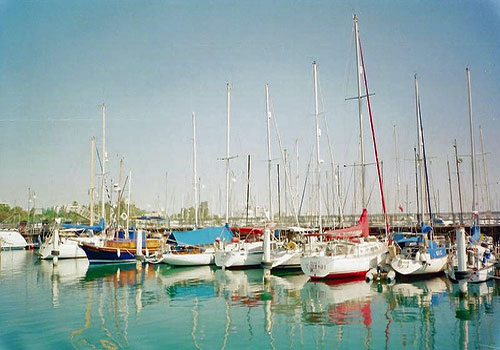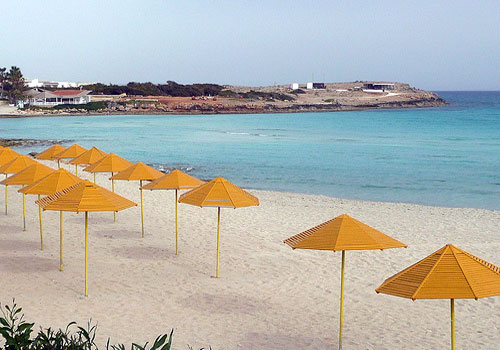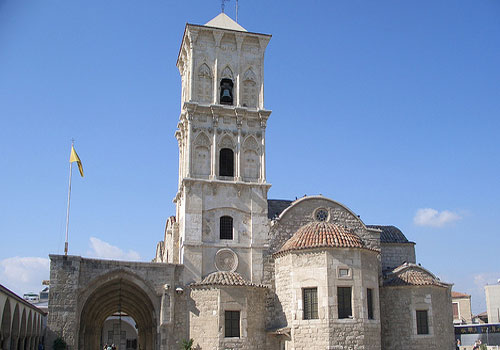Larnaca Travel Guide
Larnaca District Museum
Address: Kalogreon Square. Larnaca
Telephone: 24 304 576
Within walking distance of the town centre is the modern Larnaca District Museum, which contains an interesting collection of antiquities found in the Larnaca area, dating from the Neolithic to the Roman periods. Well-lit displays feature archaeological finds from Kition, including a ceramic collection with alabaster vases, tools, coins and lamps. Wall cases hold diverse pieces like faience scarabs, limestone seals, bone implements and engraved stone blocks.<br /><br /> There are four galleries and the objects are arranged in chronological order so that the visitor can get a more complete picture of the historical development of the ancient city of Kition and the District of Larnaka in general. There is a little garden attached to the museum which features a number of statues and is worth strolling around.<br /><br /> Note: The museum will be closed for renovations from the 8th May 2017 until November 2017.<br /><br />
Ancient Kition
Address: Larnaca
Admission: Monday to Friday 9am-2:30pm; Thursdays 3pm-5pm (except July and August).
Kition was an ancient city state on the southern coast of Cyprus, in today's Larnaca. The state was originally established by the Greeks as Kittim in the 13th century BC. In the northwest of Larnaca some of the ruins of ancient Kition can still be seen, featuring the remains of five temples dating back to the 13th century BC. Of particular interest is the Phoenician Temple of Astarte, which was built on the ruins of an earlier Bronze Age temple.<br /><br /> The lower part of the northern city walls, built of huge stones resembling Mycenaean cyclopean walls, are also still visible. Wooden walkways allow visitors a view of the excavation areas where many important artefacts have been discovered. Residents in Larnaca are still discovering artefacts all over the city, and a number of building projects in Larnaca have been abandoned due to fresh discoveries. It seems that a large portion of the ancient ruins actually lie beneath modern Larnaca. As is often the case with attractions in Cyprus, there is very little information at the site and it is best to do your research before visiting to fully appreciate the significance of what you are seeing.<br /><br />
Church of Ayios Lazaros
Address: Plateia Agiou Lazarou Larnaca
Telephone: 24 652 498
The 9th-century church devoted to St Lazarus that stands in Larnaca is an important religious institution on Cyprus. Lazarus is believed to have lived at ancient Kition for 30 years after his resurrection by Jesus Christ, and was ordained Bishop of Kition by Saints Barnabas and Mark. The Church was built by the Byzantine Emperor Leo VI above what was believed to be the empty grave of Lazarus, whose final resting place is in Marseilles, France.<br /><br /> Eight days before the Greek Orthodox Easter each year the Baroque wood-carved icon of Saint Lazarus normally stored in the church is carried in a procession through the streets of the town. This beautiful little church is only a few yards from Larnaka Beach and is easy to find. The interior is richly decorated and there is an atmosphere of profound peace. Visitors are asked to be considerate in their dress so be sure to cover up appropriately and behave respectfully in this important place of worship. It is recommended that women wear a scarf or hat on their heads.<br /><br />
Larnaca Medieval Museum
Address: Larnaca Fort Larnaca
Admission: €1,70 Open Monday to Friday.
This fascinating and well-stocked museum is housed in the upper level of the Larnaca fort on the city's seafront. The fort itself is the main attraction of the museum it houses; it was built in 1625 by the Turks to defend the city from invasion (there is still a Turkish inscription above the doorway). Later it was used as a prison during the early years of British rule. One of the most popular attractions in Larnaca, the fort also operates as the Larnaca Municipal Cultural Centre during the summer and hosts local cultural events. The museum collection itself is fairly small but impressive, containing displays from the early Christian, Byzantine, Lusignan and Ottoman periods, as well as 12th to 18th century pottery, photos of historical sites and a collection of firearms, helmets and swords dating from the 15th to the 19th century. There are great views from the top of the building which offers a lovely opportunity for taking photographs. The fort is so close to the sea that visitors walking around the sea wall might be ankle-deep in water. Beyond the fort there is a long street of restaurants and cafes where visitors can find refreshments and take a break from sightseeing.<br /><br />
Choirokoitia
Address: 32km from Larnaka, off the Larnaka – Lemesos highway Larnaca
About 20 miles (32km) from Larnaca, on the Lefkosia-Lemesos road, archaeological excavations have revealed one of the oldest Neolithic sites on Cyprus, dating to 7000 BC. Choirokoitia (also known as Khirokitia) was home to primitive farmers who cultivated wheat and barley. Visitors can explore the settlement's defensive wall, circular houses and tombs.<br /><br /> The site is close to the dry Maroni riverbed atop a hill that was once covered in dense vegetation. It was first excavated in 1934, but excavations by French archaeologists are continuing. Four of the beehive-shaped houses made of mud and stone have been reconstructed to show how these early farmers lived. Most of the archaeological finds from Choirokoitia are displayed in the Cyprus Museum in Nicosia.<br /><br /> The ruins are a UNESCO World Heritage Site and really worth a visit for anybody interested in ancient history or archeology. You will have to do a little climbing up the hillside to see the excavations and it is probably best to wear decent walking shoes and bring a water bottle; it should, however, be manageable even for the unfit.<br /><br />
Stavrovouni Monastery
Address: 40km from Larnaka, 9km off the Lefkosia-Lemesos road Larnaca
Perched on top of a solitary mountain, 25 miles (40km) from Larnaca and six miles (10km) off the Lefkosia-Lemesos Road, is the oldest monastery in Cyprus, founded in the 4th century by Saint Helena, mother of Constantine the Great. This Greek Orthodox monastery contains an important relic, a fragment of the Holy Cross. Other relics left at the monastery by Helena include the Cross of the Good Thief, a nail and, according to some sayings, a part of the rope that Jesus was tied to on the Cross. The primary relic, the fragment of the Holy Cross is now encased in a silver cross and cannot be viewed directly.<br /><br /> The mountain on which the monastery is dramatically perched, with a winding, steep road, used to be called Olympus but is now known as Stavrovouni. The monastery is considered the spiritual centre of Cyprus and now houses quite a number of monks. Recently, the monastery underwent a complete renovation; its small church was fully restored with new frescoes and icons painted by the famous artist, Fr. Kallinikos, a monk from Stavrovouni. The pictures record the legend of the foundation: St. Helena, in a brilliant red garment, finds the True Cross in Jerusalem. Unfortunately, the monastery is only accessible to men; women are not allowed to enter.<br /><br />
Lefkara
Address: Located at the foot of the Troodos Mountains, 12 kms from the Nicosia Larnaca
This beautiful village in the Troodos hills in the west of Larnaca District is famous for its handmade lace, known as lefkaritika. The village of Lefkara, which actually consists of an upper and lower town section, is off the main Nicosia/Limassol highway and features cobbled streets and picturesque architecture. Groups of women sit in the narrow village streets working on their fine embroidery, as they have for centuries.<br /><br /> The village is also known for its skilled silver smiths who produce fine filigree work, and there is a small Turkish Delight factory. A folklore museum in the town shows visitors what life was like on Cyprus a hundred years ago (in fact, the whole village feels like a folk museum). The museum is situated in a restored house and exhibits the furniture and effects of a wealthy family of the time, local costumes and examples of the Lefkara lacework.<br /><br /> Lefkara is a lovely little town which delights visitors and allows them to explore what seems like an authentic Cypriot village. The people are very friendly and welcoming and it is a good place to meet some locals. Lefkara is also a good base from which to explore a number of other little villages.<br /><br />
(Data provided outside US and Canada by Foreca, Data provided for US and Canada by WDT)
| Jan | Feb | Mar | Apr | May | Jun | Jul | Aug | Sep | Oct | Nov | Dec | |
| Average High | 15° | 16° | 18° | 21° | 25° | 28° | 31° | 31° | 30° | 27° | 21° | 17° |
| Average Low | 7° | 7° | 8° | 11° | 15° | 18° | 21° | 21° | 19° | 16° | 12° | 8° |
(Data provided outside US and Canada by Foreca, Data provided for US and Canada by WDT)
| Jan | Feb | Mar | Apr | May | Jun | Jul | Aug | Sep | Oct | Nov | Dec | |
| Average High | 60° | 61° | 65° | 71° | 77° | 84° | 89° | 89° | 86° | 81° | 71° | 64° |
| Average Low | 45° | 45° | 47° | 53° | 59° | 66° | 71° | 71° | 67° | 61° | 54° | 48° |
| Description Rectangular blade plug |
Voltage 240 V |
Frequency 50 Hz |
Type G |



